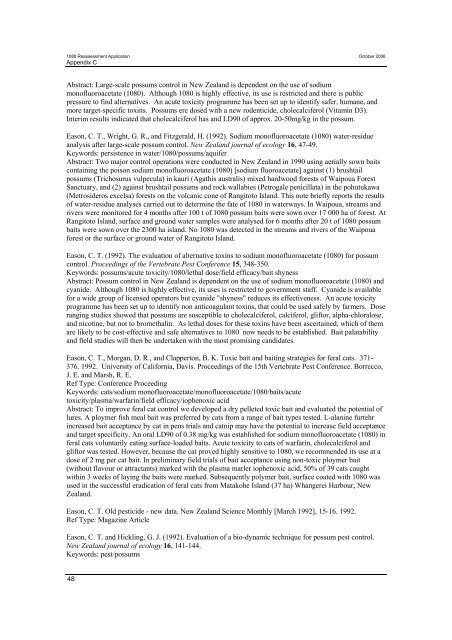Source: Landcare Research (1964). Control of poisons. Royal ...
Source: Landcare Research (1964). Control of poisons. Royal ...
Source: Landcare Research (1964). Control of poisons. Royal ...
You also want an ePaper? Increase the reach of your titles
YUMPU automatically turns print PDFs into web optimized ePapers that Google loves.
1080 Reassessment Application October 2006<br />
Appendix C<br />
Abstract: Large-scale possums control in New Zealand is dependent on the use <strong>of</strong> sodium<br />
mon<strong>of</strong>luoroacetate (1080). Although 1080 is highly effective, its use is restricted and there is public<br />
pressure to find alternatives. An acute toxicity programme has been set up to identify safer, humane, and<br />
more target-specific toxins. Possums ere dosed with a new rodenticide, cholecalciferol (Vitamin D3).<br />
Interim results indicated that cholecalciferol has and LD90 <strong>of</strong> approx. 20-50mg/kg in the possum.<br />
Eason, C. T., Wright, G. R., and Fitzgerald, H. (1992). Sodium mon<strong>of</strong>luoroacetate (1080) water-residue<br />
analysis after large-scale possum control. New Zealand journal <strong>of</strong> ecology 16, 47-49.<br />
Keywords: persistence in water/1080/possums/aquifer<br />
Abstract: Two major control operations were conducted in New Zealand in 1990 using aerially sown baits<br />
containing the poison sodium mon<strong>of</strong>luoroacetate (1080) [sodium fluoroacetate] against (1) brushtail<br />
possums (Trichosurus vulpecula) in kauri (Agathis australis) mixed hardwood forests <strong>of</strong> Waipoua Forest<br />
Sanctuary, and (2) against brushtail possums and rock wallabies (Petrogale penicillata) in the pohutukawa<br />
(Metrosideros excelsa) forests on the volcanic cone <strong>of</strong> Rangitoto Island. This note briefly reports the results<br />
<strong>of</strong> water-residue analyses carried out to determine the fate <strong>of</strong> 1080 in waterways. In Waipoua, streams and<br />
rivers were monitored for 4 months after 100 t <strong>of</strong> 1080 possum baits were sown over 17 000 ha <strong>of</strong> forest. At<br />
Rangitoto Island, surface and ground water samples were analysed for 6 months after 20 t <strong>of</strong> 1080 possum<br />
baits were sown over the 2300 ha island. No 1080 was detected in the streams and rivers <strong>of</strong> the Waipoua<br />
forest or the surface or ground water <strong>of</strong> Rangitoto Island.<br />
Eason, C. T. (1992). The evaluation <strong>of</strong> alternative toxins to sodium mon<strong>of</strong>luoroacetate (1080) for possum<br />
control. Proceedings <strong>of</strong> the Vertebrate Pest Conference 15, 348-350.<br />
Keywords: possums/acute toxicity/1080/lethal dose/field efficacy/bait shyness<br />
Abstract: Possum control in New Zealand is dependent on the use <strong>of</strong> sodium mon<strong>of</strong>luoroacetate (1080) and<br />
cyanide. Although 1080 is highly effective, its uses is restricted to government staff. Cyanide is available<br />
for a wide group <strong>of</strong> licensed operators but cyanide "shyness" reduces its effectiveness. An acute toxicity<br />
programme has been set up to identify non anticoagulant toxins, that could be used safely by farmers. Dose<br />
ranging studies showed that possums are susceptible to cholecalciferol, calciferol, gliftor, alpha-chloralose,<br />
and nicotine, but not to bromethalin. As lethal doses for these toxins have been ascertained, which <strong>of</strong> them<br />
are likely to be cost-effective and safe alternatives to 1080 now needs to be established. Bait palatability<br />
and field studies will then be undertaken with the most promising candidates.<br />
Eason, C. T., Morgan, D. R., and Clapperton, B. K. Toxic bait and baiting strategies for feral cats. 371-<br />
376. 1992. University <strong>of</strong> California, Davis. Proceedings <strong>of</strong> the 15th Vertebrate Pest Conference. Borrecco,<br />
J. E. and Marsh, R. E.<br />
Ref Type: Conference Proceeding<br />
Keywords: cats/sodium mon<strong>of</strong>luoroacetate/mon<strong>of</strong>luoroacetate/1080/baits/acute<br />
toxicity/plasma/warfarin/field efficacy/iophenoxic acid<br />
Abstract: To improve feral cat control we developed a dry pelleted toxic bait and evaluated the potential <strong>of</strong><br />
lures. A ploymer fish meal bait was preferred by cats from a range <strong>of</strong> bait types tested. L-alanine furtehr<br />
increased bait acceptance by cat in pens trials and catnip may have the potential to increase field acceptance<br />
and target specificity. An oral LD90 <strong>of</strong> 0.38 mg/kg was established for sodium mon<strong>of</strong>luoroacetate (1080) in<br />
feral cats voluntarily eating surface-loaded baits. Acute toxicity to cats <strong>of</strong> warfarin, cholecalciferol and<br />
gliftor was tested. However, because the cat proved highly sensitive to 1080, we recommended its use at a<br />
dose <strong>of</strong> 2 mg per cat bait. In preliminary field trials <strong>of</strong> bait acceptance using non-toxic ploymer bait<br />
(without flavour or attractants) marked with the plasma marler iophenoxic acid, 50% <strong>of</strong> 39 cats caught<br />
within 3 weeks <strong>of</strong> laying the baits were marked. Subsequently polymer bait, surface coated with 1080 was<br />
used in the successful eradication <strong>of</strong> feral cats from Matakohe Island (37 ha) Whangerei Harbour, New<br />
Zealand.<br />
Eason, C. T. Old pesticide - new data. New Zealand Science Monthly [March 1992], 15-16. 1992.<br />
Ref Type: Magazine Article<br />
Eason, C. T. and Hickling, G. J. (1992). Evaluation <strong>of</strong> a bio-dynamic technique for possum pest control.<br />
New Zealand journal <strong>of</strong> ecology 16, 141-144.<br />
Keywords: pest/possums<br />
48








![Application for test certificate [pdf, 131kb]](https://img.yumpu.com/50666502/1/184x260/application-for-test-certificate-pdf-131kb.jpg?quality=85)








